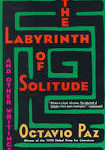In Octavio Paz’ collection of essays, The Labyrinth of Solitude, he describes the Mexican psyche and explains that Mexicans hide behind masks and rituals to conceal their immense solitude, resulting from the mestizaje prevalent throughout Mexican history, lineage, and culture. In his essay, “The Day of the Dead,” he writes, “The solitary Mexican loves fiestas and public gatherings. Any occasion for getting together will serve, any pretext to stop the flow of time and commemorate men and events with festivals and ceremonies. We are a ritual people, and this characteristic enriches both our imaginations and our sensibilities, which are equally sharp and alert” (47). He continues, “There are certain days when the whole country, from the most remote villages to the largest cities, prays, shouts, feasts, gets drunk and kills, in honor of the Virgin of Guadalupe or Benito Juárez” (47). In other words, Paz believes that fiestas are Mexicans’ only luxury, a way to temporarily escape “poverty and misery” (49). He explains that the Mexican becomes more open during these fiestas, providing the opportunity for revealing oneself.
Paz believes the modern Mexican has been shaped by his or her indigenous ancestors and Christian influences in regards to death, but has also become “modern” in the sense that death now lacks meaning. He writes, “The Mexican…is familiar with death, jokes about it, caresses it, sleeps with it, celebrates it; it is one of his favorite toys and his most steadfast love” (57). Paz closes with, “We oscillate between intimacy and withdrawal, between a shout and a silence, between a fiesta and a wake, without ever truly surrendering ourselves. Our indifference hides behind a death mask; our wild shout rips off this mask and shoots into the sky, where it swells, explodes, and falls back in silence and defeat. Either way, the Mexican shuts himself off from the world: from life and from death” (64).
As I read Paz’s essay, I could clearly see his use of Gothic elements and the uncanny. His discussions of violence, solitude, death, and overall darkness evoke Gothic themes. For example, during the celebration of Día de los Muertos, it is common for people to paint calaveras (skulls/skeletons) on their faces. One of the purposes of the calaveras is to demonstrate that “death is the great leveler” of us all; in other words, our social, political, and economic statuses become the same in the hereafter (Tatum, 184). Tying the face-painting to Paz’s philosophy of Mexicans being mask wearers, I believe this painted “mask” is a physical example of a Mexican’s emotional masks being worn.
Works Cited:
Paz, Octavio. “The Day of the Dead.” The Labyrinth of Solitude. New York: The Grove Press, 1985. 47-64. Print.
Tatum, Charles M. “Art, Celebrations, and Other Popular Traditions.” Chicano Popular Culture. Tucson: The University of Arizona Press, 2001. 153-190. Print.
Book Image: Courtesy of Google Books
Día de los Muertos Image: Self-image



I wanted to further expand on the idea of having a positive, intimate relationship with death. One of my prize-possessions is an autographed copy of Rosita y Conchita, a children’s book about two sisters – one living, one dead – who look forward to finding each other on Dia de los Muertos. I love this book because it provides the perfect opportunity to introduce the culture and the traditions behind this holiday to younger audiences, which is particularly useful for those who have never heard of it. I imagine how awkward, though, it must be for a child who isn’t at all familiar with this holiday to process what it’s all about, especially when they it’s more likely than not that they have grown up around Halloween and have embraced all of the things associated with that. I’m sure that from an outsider’s perspective, Dia de los Muertos appears uncanny for it isn’t normal to embrace death, celebrate death, call down the spirits of the dead, and be one with them. I find it funny that many people consolidate the two events when, clearly, they seem to be completely opposite by their very nature. If you haven’t had the opportunity to read it, I definitely recommend Rosita y Conchita. I know it can seem a little pricey but it’s definitely worth the investment! Here’s a sample: http://fc01.deviantart.net/fs70/i/2013/105/2/e/rosita_y_conchita_grief_poem_by_chiacheese-d61ux73.jpg